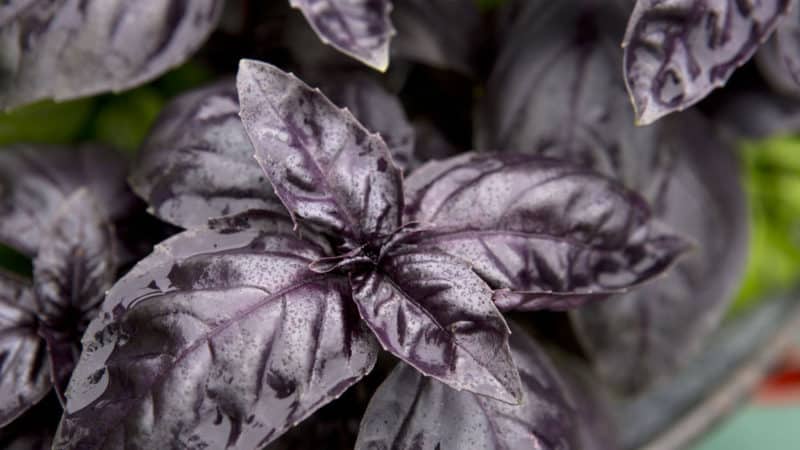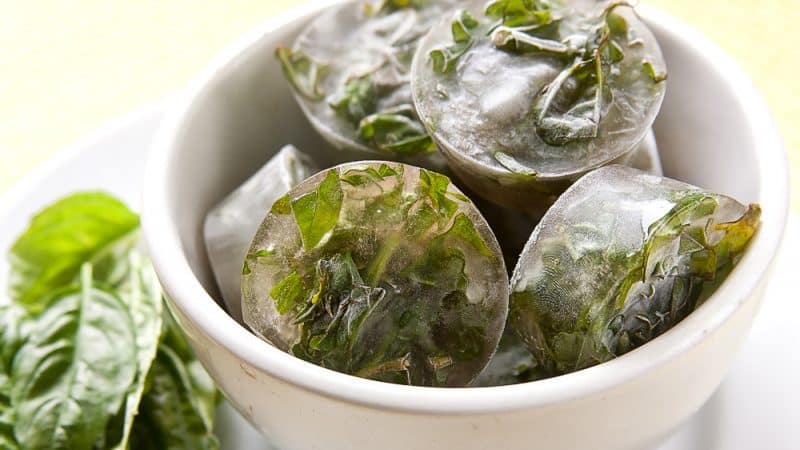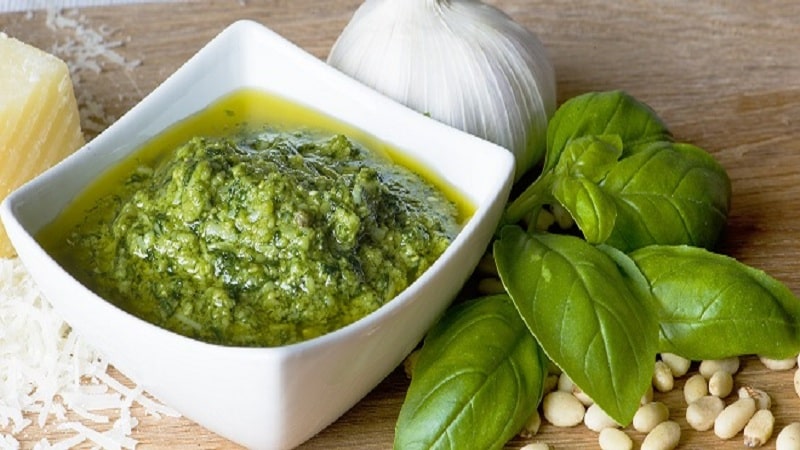When and how to harvest basil correctly: a guide to harvesting and storing the crop
Basil is an annual herb that has been known since ancient times. It is cultivated in open ground, greenhouses and even in flower pots for use as a seasoning for fresh salads, soups, meat and fish dishes. The unpretentious crop is easy to grow. The main thing is to harvest the crop in a timely manner and preserve it so that the healing properties and taste characteristics are not lost. We will tell you in this article when and how to properly pick basil in the garden.
Timing for harvesting basil

The taste of spicy herbs is slightly bitter and at the same time has a sweetish aftertaste. The aroma of different varieties can be cinnamon, lemon, mustard, etc. When growing When using herbs, it is important not to miss the moment when the greens are ready for cutting, otherwise the leaves will become tough and tasteless.
Basil begins to be used when the height of the greenery reaches 10-12 cm, and continues to be collected throughout the summer.
The main raw materials are the tops of shoots with young leaves, although many use more mature ones (for example, for brewing tea).
Collect before flowering begins, as soon as the first buds appear on the bushes - in late July - early August. It is at this time that basil acquires a particularly strong aroma. The maximum amount of essential oils accumulates in greenery. After flowering, the leaves of the plant lose their rich spicy smell.
Attention! Basil is harvested only in dry weather.
After the first harvest, the plant must be fed.Usually complex mineral fertilizer is used. The planting beds are weeded and the row spacing is loosened. In this way, the crop is prepared for the next harvest. When creating similar growth conditions for basil from 1 sq. m collect 1 kg of fresh herbs. After harvesting, this volume will yield about 0.2 kg of dry seasoning.
What do they depend on?
When to cut basil depends on many factors:
- Features of the climatic conditions of different regions of Russia, in which the timing of basil harvesting varies greatly. For example, in the southern regions it is cut 2-3 times, in the northern regions - once.
- Weather. If the summer is rainy and cold, crop growth slows down and harvest dates are delayed. In warm and dry summers, spicy herbs actively grow, so gardeners have time to harvest more than once.
- Biological ripeness. After 4-6 weeks, the spice can already be collected, but provided that it has developed under favorable weather conditions.
- Agricultural technicians. If the care of the spice plant was inadequate or completely absent, the harvest time will be delayed by days or even weeks.
How to harvest basil correctly
Once the basil bushes reach the desired height, you can begin harvesting.
Cutting
It is important to cut basil before it blooms. After it, the leaves partially lose their taste and characteristic aroma and become tougher. Only the upper part of the plant is cut off - the top with buds and a few leaves. This will also allow the bush to recover faster and produce the next harvest. At this time, new side shoots with tender young leaves grow from the buds. The plant becomes even more lush and attractive, thus gaining green mass. After 2-3 weeks, they begin to cut again.
The procedure is performed using a sharp knife, pruning shears or scissors. As a last resort, simply pinch off the top by hand.
This procedure is carried out several times throughout the season. After each pinching, the plant is given time to form flower stalks, and the side leaves are torn off for daily use.
It is important that the crop is kept dry and sunny during harvest. In rainy and damp weather, leaves accumulate a lot of moisture, which will negatively affect the quality of storage of raw materials - they will dry out.
Reference. The entire above-ground part of the bush is cut off before the first autumn frosts.
Pulling
In order for basil to repeatedly bear fruit, you should never pull out the bushes by the roots.
How many times per season can you harvest basil?
During the season, experienced gardeners harvest 2-3 crops (at the end of June, mid-August, end of September), because they do it correctly and in a timely manner.
Basil is a heat-loving plant. Before the onset of the first frost, it is transplanted into a greenhouse or house. The seasoning grows without problems in flower pots. It not only decorates and fills the house with a spicy aroma, but also provides fresh herbs all year round.
How to store it
Fresh store basil difficult, because the leaves have a very delicate structure. They quickly lose their flavor and darken.
To prolong the freshness of greens, do the following:
- Cut branches are placed with stems in a jar or glass of water.
- Keep the container in a place where it is not exposed to sunlight.
- The shelf life of such basil reaches 15 days.
The upper part of the bundle, which sticks out of the jar, is covered with a plastic bag. After this, its edges are pressed with an elastic band. This way the greens will stay fresh for a week longer, i.e. 20-22 days.
If the amount of basil is small and you plan to use it in the coming days, wrap the branches with leaves in a damp towel. The bundle is then placed in a bag and sent to fridge. This will help preserve the delicate spice for several days.
Also, fresh basil is chopped, placed in a jar, a couple of pinches of salt are added and poured with olive oil. The container is stored only in the refrigerator. This way the shelf life of basil is extended to 3 months. The oil is then used to make salads.
Harvesting methods
To prepare basil for the winter, use the following methods:
- dried;
- frozen;
- canned.
Drying
The method allows you to preserve the taste and beneficial qualities of the plant. Basil is dried in the open air, in an electric dryer or oven.
Drying outside allows you to preserve the vitamins and aroma of the seasoning as much as possible. There are 2 main methods of natural drying:
- The leaves are laid out on a baking sheet and stored in a dry and warm room. Cover the top with gauze to prevent flies.
- Bunches are formed from the branches and hung in a room with good air circulation.
Air drying takes 2-3 days.
Oven drying is the fastest method. But in this case, there is a possibility that the basil will lose most of its beneficial substances due to overdrying.
Cover a baking sheet with parchment paper and place the leaves on it in one layer. Dry at temperatures from +40 to +50°C. Drying takes 1 hour with the door open.
It is most convenient to use an electric dryer. Modern models allow you to preserve all the vitamins and nutrients in greens. Leaves are laid out on pallets in 1 layer. Heating temperature – +40°C, duration – 1 hour.
Freezing

Freezing is considered the best way to preserve a product if you follow all the rules.The packaging must be such that it does not allow moisture and air to pass through, and is easy to open and close. It is best to use plastic containers.
Freeze in several ways:
- fresh;
- blanched;
- in olive oil.
When frozen fresh, the leaves are washed, dried and placed in a container. After that they are sent to the freezer.
Blanching allows you to kill bacteria and fungi, remove excess bitterness and preserve the structure of the leaves. Bring the water to a boil, place the basil in a colander and lower it into boiling water for 5 seconds. After this, take it out and dip it in ice water. Dry the basil on paper towels, transfer it to a freezer container and put it in the freezer.
To freeze basil in olive oil, first blanch it. After this, it is crushed using a blender or cut with a sharp knife. The greens are poured with olive oil, the proportions are not important. The mixture is mixed and placed into ice trays. The frozen cubes are transferred to a bag.
Reference. Olive oil does not lose quality after freezing, because it does not come into contact with air and does not oxidize.
Canning

Basil can be preserved like other herbs, such as sorrel or dill. Blanch the leaves and add salt to taste. After this, they are compacted into sterilized jars with a volume of 0.5 or 0.25 liters until the juice is released. The jars are placed in a water bath and sterilized for 20 minutes. Then seal with lids.
How to collect seeds
The exact timing of seed collection cannot be given. They depend on the care of the plant, planting time and climate in a particular region. But usually the seeds ripen from the second half of July to the beginning of August. Flowers bloom simultaneously with the formation of seeds.They are cut off so that the plant devotes all its energy to ripening the planting material.
To understand that the inflorescences are ready for harvesting, they are carefully inspected. If the bracts have dried and turned black, the seeds are ready.
Important! Collection is carried out only in calm and dry weather. High air humidity affects seed storage. Even after drying, there is a possibility of mold growth.
Collection process:
- The plant is carefully examined, large seeds are selected.
- Using a sharp knife or scissors, cut off the inflorescences. In this case, they necessarily capture part of the peduncle.
- Bunches are formed from inflorescences.
Before threshing the seeds, the plant is dried. The bunches are hung in a dry and well-ventilated area for 2 weeks. The basil should not be exposed to direct sunlight, as this will reduce germination.
To separate the seeds from the testes, the dried inflorescences are rubbed by hand. After this, everything is poured onto a sieve with large holes. They blow in windy weather outside.
After threshing, the seeds are dried again. To do this, they are laid out on baking sheets or cardboard and transferred to a dry room. Drying requires 2-3 days. They are turned over every day.
The nuances of their storage
The germination of seeds depends on compliance with the rules of their storage. To do this, use boxes made of thick paper or cardboard. Canvas bags are also used. They help protect planting material from damage. It is not recommended to use bags or plastic containers, because without air access the seeds will begin to rot.
During storage, raw materials are regularly checked. If the seeds are damp, pour them onto a paper towel and dry naturally for 2 days.
Conclusion
Basil is harvested at the designated time, before flowering begins.Be sure to use in dry weather, as the shelf life of the spice depends on this. Basil is usually stored fresh, but in large quantities it is frozen, canned or dried.